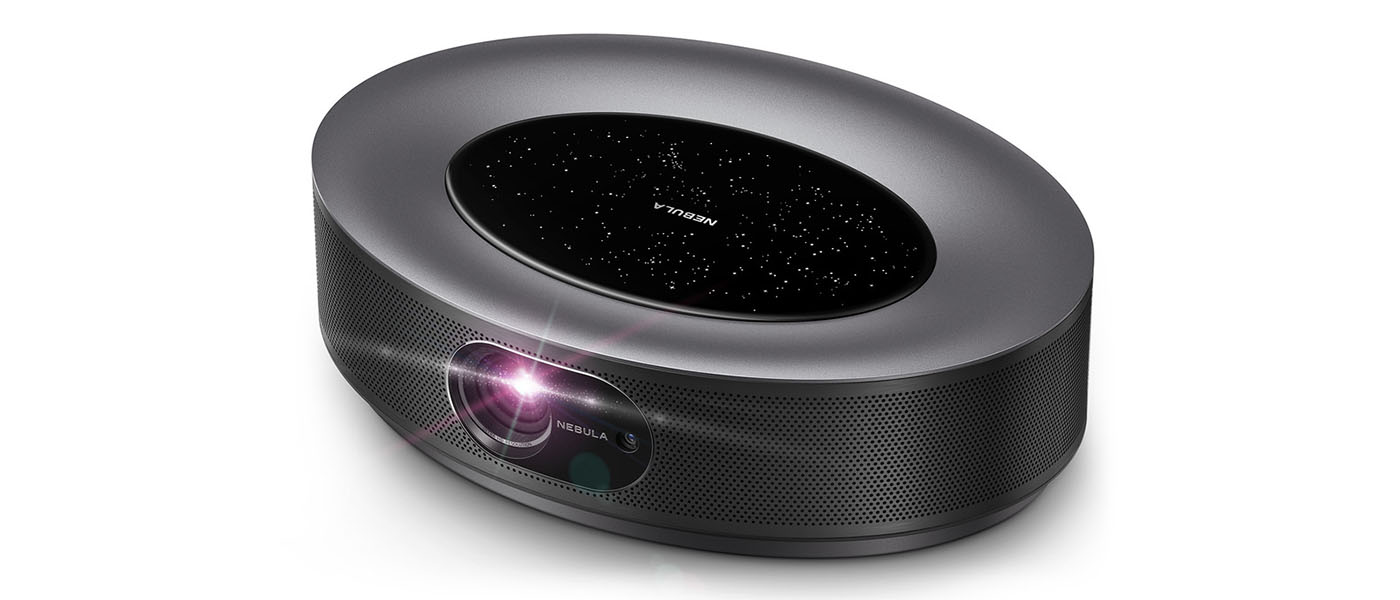The Optoma CinemaX P1 Ultra Short Throw 4K Projector is a self-contained entertainment component that can put a 120” image on a wall or screen from just inches away. Its elegantly-styled chassis houses a 0.47” DLP chip with a laser phosphor light engine. Four speakers provide quality audio with tuning by NuForce. It’s a sleek solution for those who want a big-screen TV but don’t want to hang a heavy panel on the wall.
Optoma CinemaX P1 UST 4K Projector
- Single-chip 0.47” DLP with XPR technology
- 20,000-hour laser phosphor light engine
- Projects a 120” image from 14 inches away
- HDR10, HLG (via USB only) and 3D support
- Stylish chassis with built-in speakers by NuForce
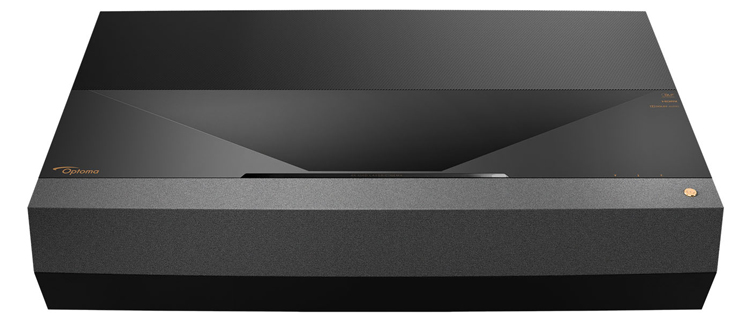
Ultra-short throw projectors fill a unique need in the display genre. They sit just below the screen a few inches from the wall and create a large image; in the case of the Optoma CinemaX P1, up to 120 inches diagonal. Designed to replace your television, the P1 features a laser phosphor light engine rated for 20,000 hours. At five hours a day, seven days a week, that’s almost 11 years of watching.
With a 0.47” DLP chip, it runs at a resolution of 3840×2160 pixels at up to 60Hz. Three HDMI 2.0 inputs ensure compatibility with the latest content. Support for HDR10 and Hybrid Log Gamma (HLG) boosts dynamic range along with three dynamic contrast modes. Four built-in speakers in front provide solid audio thanks to Optoma’s partner company, NuForce. It’s all wrapped in a stylish chassis that sits unassumingly on a bench or table just in front of the screen. I wouldn’t call it portable, but it can be set up just about anywhere with sufficient wall space to accommodate a screen.
Type:
Single-chip DLP 0.47” with XPR technology
Color wheel:
8-segment RGBYRGBY
Native resolution:
1920×1080, 3840×2160 w/XPR pixel-shift, 16:9 aspect ratio
HDR:
HDR10, Hybrid Log Gamma via USB only
3D:
Yes
Light source:
laser phosphor
Light output (mfr):
3000 ANSI lumens
Lamp service life:
20,000 hours
Video connections:
3x HDMI 2.0 (1 w/ARC)
Audio connections:
3.5mm audio out, optical S/PDIF out
Additional connections:
3x USB, RJ-45
Speakers:
2x full-range drivers, 2x woofers, 40 watts total
Dimensions:
22.1” x 5.1” x 15” (WxHxD)
Weight:
24.25lbs
Warranty:
2 years, 5 years/12,000 hours laser
Optoma CinemaX P1 UST 4K Projector Price:
$3799
Manufacturer’s website:
Company:
SECRETS Tags:
Projector Review 2020, optoma, cinemax p1, 4k, ultra hd projector, dlp projector, hdr, ultra hd, 3d
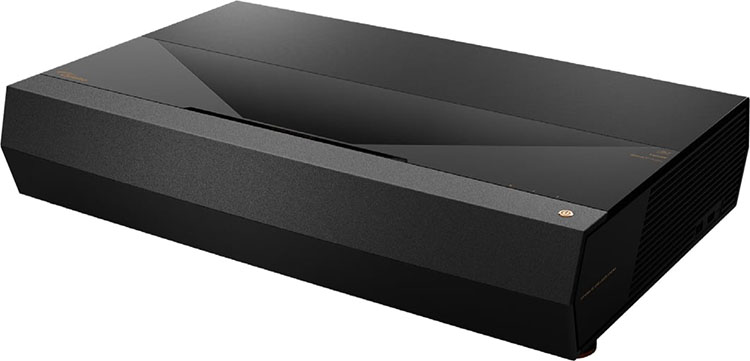
The CinemaX P1 uses a clever system of mirrors and a special lens to throw an image up to 120” diagonal from just 14 inches away. Inside is a 0.47” DLP chip and a laser phosphor light engine. Resolution is 3840×2160 which is achieved with XPR pixel-shift technology. After reviewing many DLP projectors with this system, I have found that it’s nearly indistinguishable from a native 4K display. Optoma uses premium optics to achieve a razor-sharp picture.
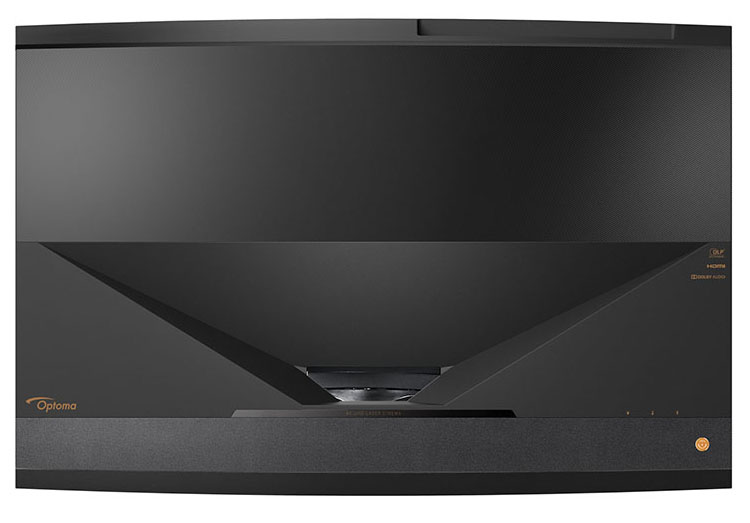
The laser phosphor light engine is rated for 20,000 hours and is maintenance-free. If you watch for five hours a day, every day, it’ll take almost 11 years to use it up. And during that time, the light level won’t degrade like a UHP lamp.
The color wheel is an eight-segment unit in an RGBYRGBY configuration. That means rainbow effects are nearly eliminated. I’m not particularly sensitive to them but if I flick my eyes from side to side, I sometimes see them. I did not see them from the P1.
Secrets Sponsor
Optoma has included support for both HDR10 and HLG (via USB only) in the P1. To deliver extra contrast, it offers three dynamic black modes which vary brightness on a frame-by-frame basis. In practice, it increases contrast by quite a bit. The most aggressive mode, Dynamic Black 3, will shut off the laser completely when no signal is present. The P1 also accepts 3D signals in frame-pack, top/bottom, and side-by-side formats. Max 3D resolution is 1920×1080. You can use any brand of DLP-Link glasses to view 3D movies. I used my trusty pair from XPand.
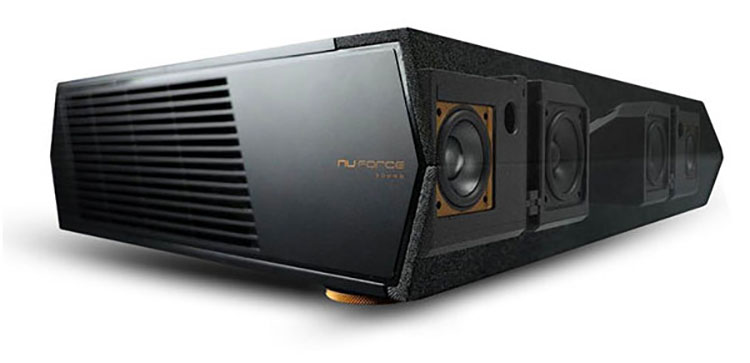
Audio is provided by a four-speaker NuForce soundbar built into the front of the box. Two full-range drivers and two woofers (40 watts total power) deliver an excellent sound that is the equal of any small soundbar I’ve heard. If you want to connect to an external system, there is a S/PDIF optical port that supports Dolby Digital Plus up to 5.1. Or you can use the HDMI ARC connection which adds support for Dolby Atmos. Two additional HDMI inputs are provided and all three are version 2.0 with HDCP 2.2.
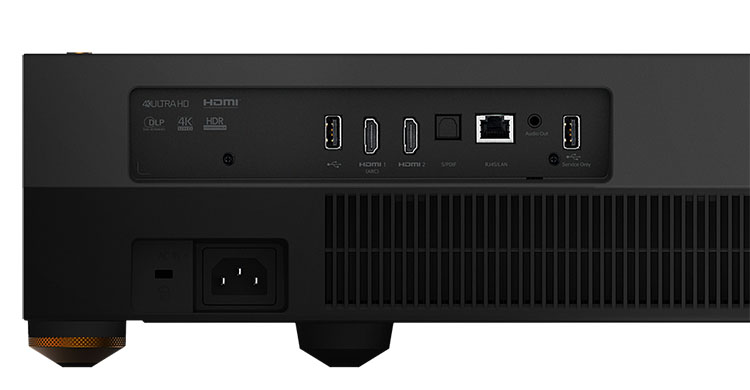
The remote is a tiny handset that works via Bluetooth. During the initial setup, the user is prompted to pair it, then it works without pointing. It has navigation control for menus and the built-in streaming interface. A long press of the home button brings an on-screen mouse cursor which responds to movements of the handset. It’s similar to LG’s magic remote in this regard and the pointer is very easy to maneuver. The remote is backlit but the icons printed on the buttons are only visible when the light is on. You need to press a button to activate the light so it’s best to remember at least one key’s function.
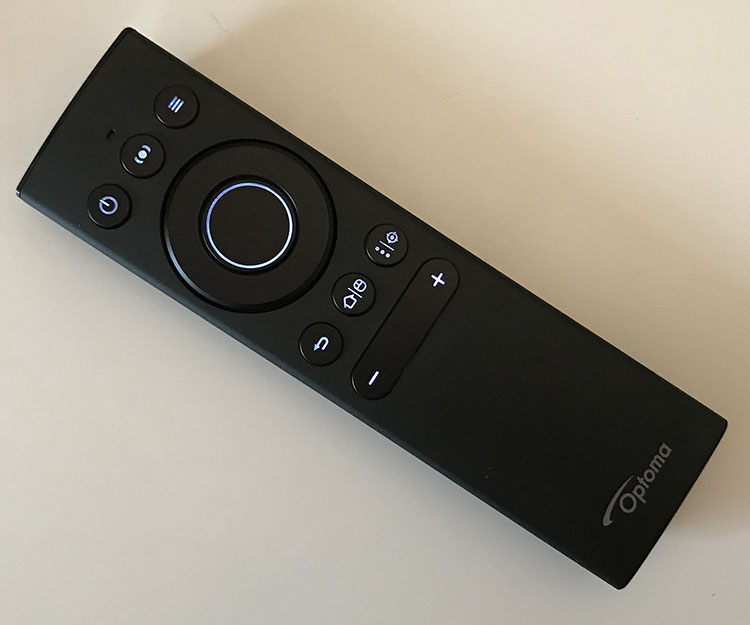
The P1 includes the latest media connectivity with voice control through Google Assistant and Amazon Alexa. The InfoWall feature delivers news and information plus a photo gallery that displays static images on the wall. AndroidOS is provided with downloadable apps for your favorite streaming providers like Netflix and Amazon. You can also play media through the USB port from a stick or portable hard disk.
I set the CinemaX P1 up on a small table beneath my Stewart Studiotek 130 screen. The best screen for any UST projector is a lenticular model like the Stewart Balon Edge or SI Short Throw ALR. But my Stewart did an excellent job in my darkened theater with over 170 nits of peak brightness. The laser power is adjustable in 5% increments or you can use one of three Dynamic Black modes to increase contrast.
Tweaking the geometry is best accomplished by positioning the projector precisely. Only slight movements are required to square and size the image. In front are two leveling feet that help as well. Once this is done, the motorized focus can be adjusted with the remote and a built-in test pattern. Sizing is done by sliding the P1 closer or further from the wall. Optoma includes plastic templates to help the user achieve a precise image size. Image warping functions are included as well, controllable from a smartphone app called SmartFIT. These should be used sparingly as they can reduce resolution
Once connected to my home’s Wi-Fi, I was able to explore the P1’s media interface. It’s Android-based and includes only basic apps. But you can easily download what you need in a few minutes. I installed Amazon, Netflix, and YouTube in short order. The remote has a mouse function activated by a long press of the home button. Then you can wave the handset to move an on-screen cursor. I quickly breezed through my saved content and had little trouble finding something to watch.
To access the P1’s image controls, press the top-right button to bring up the menu. There, you’ll find picture modes (six plus HDR, HLG, 3D, and five ISF settings memories), gamma presets, color temp presets, RGB gain/bias, color management, and brightness mode. This controls overall light output and you can either choose a percentage (50-100% in 5% increments) or one of three Dynamic Black modes. These vary the laser brightness with 3 being the most aggressive. I found DB1 worked best and increased contrast by a factor of four.

After dialing in the P1’s calibration, I rounded up a few Ultra HD Blu-rays to watch. Starting with Deadpool 2, I noticed that while Deadpool’s red suit was a bit redder than its SDR counterpart, it wasn’t quite as saturated as some other Ultra HD displays I’ve seen. Blues were in abundance, however. The sky was a brilliant hue as were the blue highlights on street signs, cars, and buildings. Other colors looked natural and accurate. The real star here though is sharpness. The P1 throws a razor-sharp image when fed Ultra HD material from Blu-ray. The detail was off the chart with even the tiniest skin pores and textures clearly visible. Black levels were good but not great; about equal to any other DLP projector. While HDR adds a bit of contrast, blacks just aren’t as true as what LCD and LCoS displays can produce.
Transformers, The Last Knight has plenty of brightly lit scenes to enjoy. This is where the P1 truly shines. Since most of the characters are CGI, the detail and dimension are just awesome. Highlights pop with fine textures and the glint of metal creating an almost tactile experience. This film was as close as I got to watching sports; a genre the P1 would truly excel at.
There are plenty of space battles in Star Wars, The Rise of Skywalker to test the P1’s black levels. Pure black star fields rendered nicely thanks to the Dynamic Black feature. When more elements were on screen, however, black levels rose a bit to a very dark gray. Ships still looked totally realistic thanks to that sharp DLP chip. Scenes shot planet-side were satisfying with realistic flesh tones and lush green jungle landscapes.
The CinemaX P1 is the first 3D projector I’ve reviewed that has zero crosstalk. I mean completely zero, nada, nothing. While anything up to 1% is acceptable, I could instantly see the difference when watching Avatar. The P1’s 3D effect is hands-down the best I’ve experienced. I carried over the same luminance and color settings from the SDR Reference mode and enjoyed good contrast and accurate hues throughout; well, accurate to the non-existent world of Pandora that is. If you’re a fan of 3D, this projector has no equal.
Secrets Sponsor
The CinemaX P1 has six image presets for SDR content plus four additional ISF memories which I did not use. The best starting point is called Reference. The P1 has an expanded color gamut which is used for all content, SDR and HDR. To run my tests and calibrate, I set Brightness Mode to 95%. After calibration, I used Dynamic Black 1 to view content.

In Reference mode, the default color temp is called Normal but as you can see, it runs quite cool. Gamma is also quite light at the lower end of the brightness scale which leaves blacks looking gray and washed out.

To address these issues, I first adjusted the basic brightness and contrast sliders. After a bit of tweaking, and a change to gamma preset 2.4, I managed to flatten out the luminance tracking to within a few whiskers of 2.2 across the board. Changing to the Warm color temp and a few clicks of the RGB sliders reduced grayscale errors to invisible levels except for a slight dip in green at 60%. This is impossible to detect in actual content.
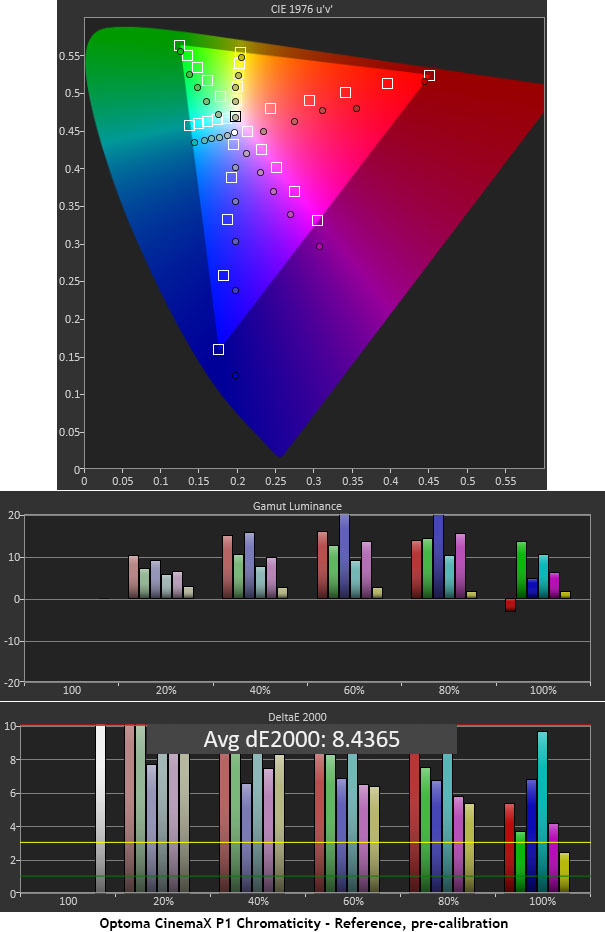
My initial gamut test shows an expanded color space focused on the blue primary. Red and green are right on target for Rec.709 at the 100% saturation points. Grayscale errors pull the cyan and magenta secondaries off-hue and overall gamut luminance is a bit high.
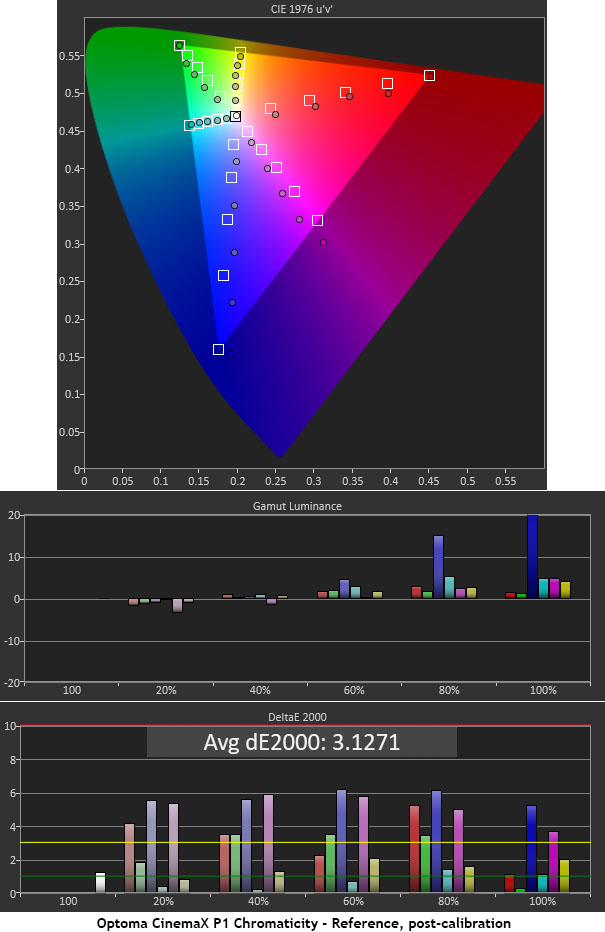
After dialing in grayscale and gamma, and adjusting the CMS sliders, the average error is reduced to 3.1271dE, a significant and visible gain in accuracy. I also reduced the Brilliant Color slider to 1, it’s lowest setting. Blue is still a little over-saturated but most content doesn’t show this error. This is a solid performance.
To simulate an HDR10 signal, I added an HD Fury Integral to the signal path. It creates the proper tone map to allow HDR measurements using CalMAN’s special workflow. The CinemaX P1 automatically switches to HDR mode when properly signaled. Image color settings are inherited from SDR mode, but you get four HDR-specific modes. I chose Standard as the most accurate.
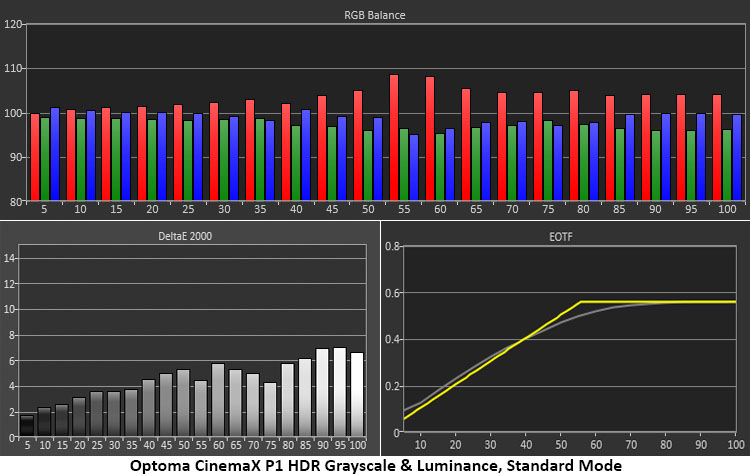
The Standard HDR mode shows a slight warmth at the tone-mapping transition point but is mostly neutral elsewhere in the brightness scale. The luminance curve sticks close to the target line with a soft transition at 55%. These results were recorded in the Dynamic Black 1 mode which does an excellent job at increasing contrast. Highlights pop and shadow detail is strong.
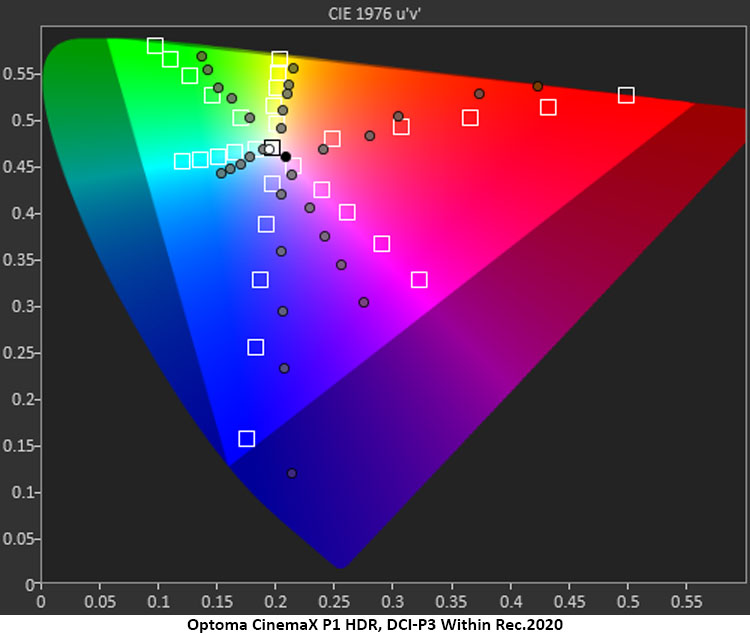
The CinemaX P1 has plenty of color on the blue and magenta side of the DCI triangle but comes up short for red and green. Color, in general, is a little more brilliant with HDR content but this projector doesn’t quite have the extreme saturation of a flat panel TV like the VIZIO PX65-G1. I calculated the overall gamut volume at 82% of DCI-P3.

The CinemaX P1 aced all the resolution and level threshold tests. Regardless of signal format, the resolution was solid down to the one-pixel burst pattern. When viewing interlaced content, both video and film cadences showed moiré in the speedway clip from Spears & Munsil’s Blu-ray benchmark disc. 24p clips rendered correctly with smooth camera pans and the ship sequence with its myriad of fine diagonal lines showed no evidence of edge enhancement once the sharpness control was turned down.
All luminance values are expressed here in nits, also known as candelas per square meter (cd/m2). For those needing a frame of reference, 1fL equals 3.43 nits, or 1 nit equals .29fL.
The CinemaX P1 is very bright at its maximum output setting. When measured from 10 feet back, I recorded 170.9685 nits white, .2457 nit black, and a native contrast ratio of 695.7:1.
In the Dynamic Black 1 mode, contrast is far better with 166.6959 nits (571.7 lumens) white, .0589 nit black, and 2832.5:1 contrast. If you want even more dynamic range, Dynamic Black 2 delivers 168.1297 nits (576 lumens) white, .0234 nit black, and 7188.7:1 contrast. This mode will show occasional flickering as light levels are adjusted on the fly. Dynamic Black 3 is very aggressive and shuts off the laser for zero-level signals rendering the black level unmeasurable.
3D is on the dim side at just 19.6794 nits (67.42 lumens) white, .1265 nit black, and 155.5:1 contrast. But the P1 is the first projector I’ve reviewed that has zero crosstalk. I literally turned down the pattern all the way and still could not produce the artifact. This translates to the best possible 3D stage with almost limitless depth to the effect.
HDR looks best in the Dynamic Black 2 mode and measures 301.2431 nits (1032.06 lumens) white, .0684 nit black, and 4406.9: contrast.
- Mode Reference
- Brightness -2
- Contrast 3
- Color/Tint 0
- Sharpness 4
- Gamma 2.4
- Color Temp Warm
- Red gain -1
- Green gain 1
- Blue gain 0
- Red bias 1
- Green bias 0
- Blue bias 0
- CMS H S G
- R -4 0 3
- G -19 2 -11
- B -15 0 -11
- C -34 -10 -5
- M 22 -4 0
- Y -22 -4 0
- Brilliant Color 1
- Dynamic Black 1
HDR – Inherits settings from SDR mode. Set Standard mode for best accuracy.
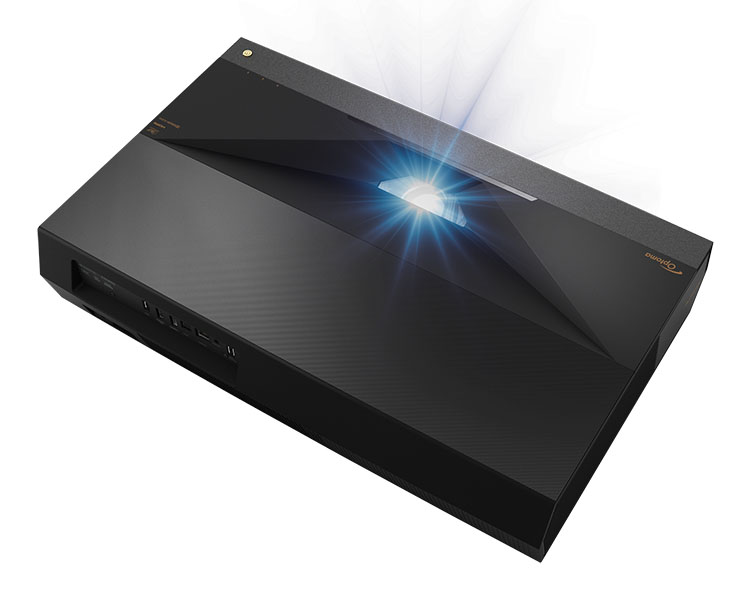
The OPTOMA CINEMAX P1 UST PROJECTOR competes well with other all-in-one projection displays. It provides a sharp bright picture at a price point squarely between budget and premium.
- Sharp, bright image
- Best 3D I’ve ever seen
- Excellent audio quality
- Elegant styling
- Easy to use
- Larger color gamut
- Better out-of-box color accuracy
When taken in the context of its intended market, the Optoma CinemaX P1 does everything well. It’s easy to set up and use. It includes excellent sound through its four NuForce-tuned speakers. Image quality is razor-sharp with good color and decent HDR performance. Ultra HD material looks particularly good and 1080p content is rendered with a quality upconversion.
The P1’s best feature by far though is its 3D. Though this format is largely dead, it still has some die-hard fans. This projector is without a doubt the best 3D display I’ve ever seen. The effect is so strong, you feel as though you could walk right into the scene. Don’t be put off by its relatively low 3D light level. The complete lack of crosstalk more than compensates.
As a single-box component, the P1’s streaming interface is basic. But once you download a few apps, you can have content from your favorite carrier on the screen in minutes. I spent hours watching Netflix and Amazon using the handy remote and its on-screen mouse cursor. And for those who like to talk to their electronics, Alexa and Google Assistant are included.
The Optoma CinemaX P1 Ultra Short Throw Projector is a worthy television replacement. You can enjoy a bright and sharp 120-inch image by placing it on a bench beneath your screen just 14 inches away. Sound is plentiful and of high quality and three HDMI inputs interface with any video component you care to connect. Versatility and quality abound in an elegantly styled package. The CinemaX P1 comes highly recommended.


